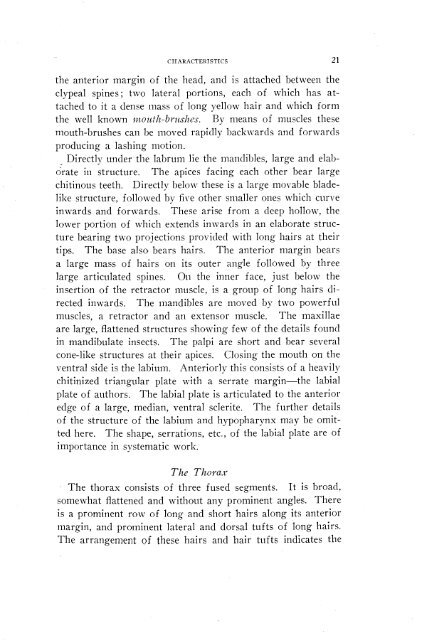a handbook of the mosquitoes of north america - Systematic Catalog ...
a handbook of the mosquitoes of north america - Systematic Catalog ...
a handbook of the mosquitoes of north america - Systematic Catalog ...
Create successful ePaper yourself
Turn your PDF publications into a flip-book with our unique Google optimized e-Paper software.
CHARACTERISTICS 21<br />
<strong>the</strong> anterior margin <strong>of</strong> <strong>the</strong> head, and is attached between <strong>the</strong><br />
clypeal spines ; two lateral portions, each <strong>of</strong> which has at-<br />
tached to it a dense mass <strong>of</strong> long yellow hair and which form<br />
<strong>the</strong> well known Plzozl.t/z-brzzslzes. By means <strong>of</strong> muscles <strong>the</strong>se<br />
mouth-brushes can be moved rapidly backwards and forwards<br />
producing a lashing motion.<br />
_ Directly under <strong>the</strong> labrum lie <strong>the</strong> mandibles, large and elab-<br />
drate in structure. The apices facing each o<strong>the</strong>r bear large<br />
chitinous teeth. Directly below <strong>the</strong>se is a large movable blade-<br />
like structure, foIllowed by five o<strong>the</strong>r smaller ones which curve<br />
inwards and forwards. These arise from a deep hollow, <strong>the</strong><br />
lower portion <strong>of</strong> which extends inwards in an elaborate struc-<br />
ture bearing two projections provided with long hairs at <strong>the</strong>ir<br />
tips. The base also bears hairs. The anterior margin bears<br />
a large mass <strong>of</strong> hairs on its outer angle followed by three<br />
large articulated spines. On <strong>the</strong> inner face, just below <strong>the</strong><br />
insertion <strong>of</strong> <strong>the</strong> retractor muscle, is a group <strong>of</strong> long hairs di-<br />
rected inwards. The mandibles are moved by two powerful<br />
muscles, a retractor and an extensor muscle. The maxillae<br />
are large, flattened structures showing few <strong>of</strong> <strong>the</strong> details found<br />
in mandibulate insects. The palpi are short and bear several<br />
cone-like structures at <strong>the</strong>ir apices. Closing <strong>the</strong> mouth on <strong>the</strong><br />
ventral side is <strong>the</strong> labium. Anteriorly this consists <strong>of</strong> a heavily<br />
chitinized triangular plate with a serrate margin-<strong>the</strong> labial<br />
plate <strong>of</strong> authors. The labial plate is articulated to <strong>the</strong> anterior<br />
edge <strong>of</strong> a large, median, ventral sclerite. The fur<strong>the</strong>r details<br />
<strong>of</strong> <strong>the</strong> structure <strong>of</strong> <strong>the</strong> labium and hypopharynx may be omit-<br />
ted here. The shape, serrations, etc., <strong>of</strong> <strong>the</strong> labial plate are <strong>of</strong><br />
importance in systematic work.<br />
The Thorax<br />
The thorax consists <strong>of</strong> three fused segments. It is broad,<br />
somewhat flattened and without any prominent angles. There<br />
is a prominent row <strong>of</strong> long and short hairs along its anterior<br />
margin, and prominent lateral and dorsal tufts <strong>of</strong> long hairs.<br />
The arrangement <strong>of</strong> <strong>the</strong>se hairs and hair tufts indicates <strong>the</strong>

















